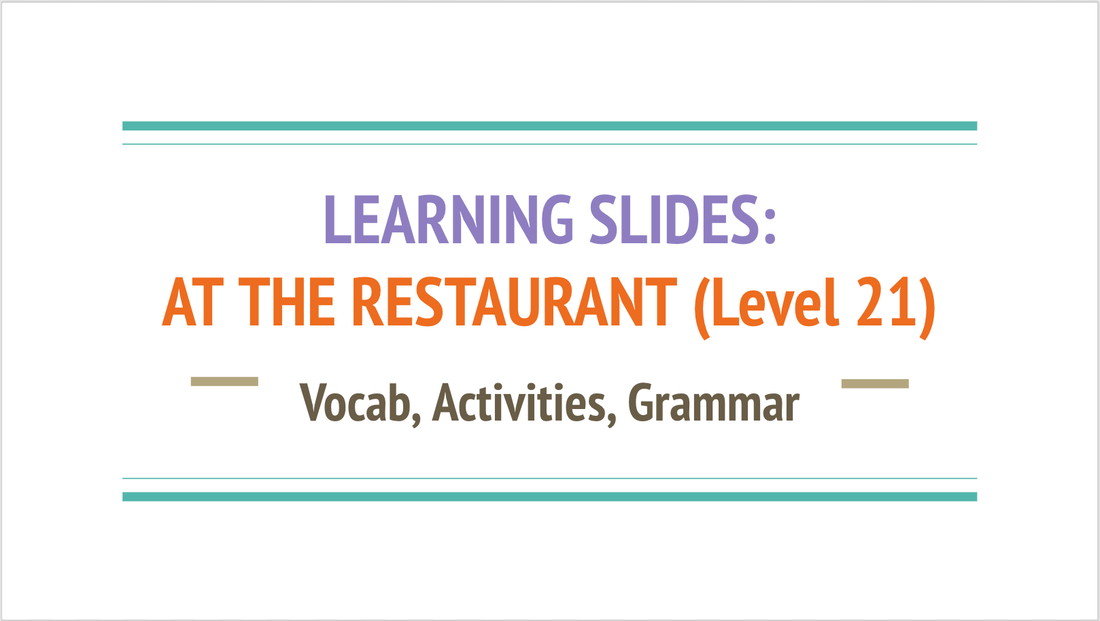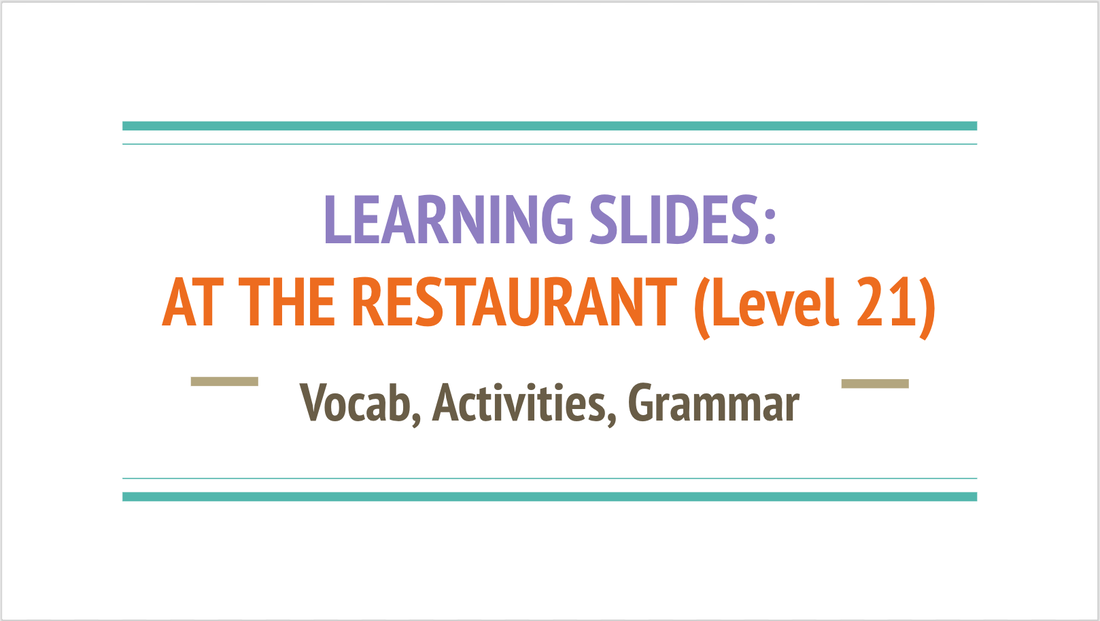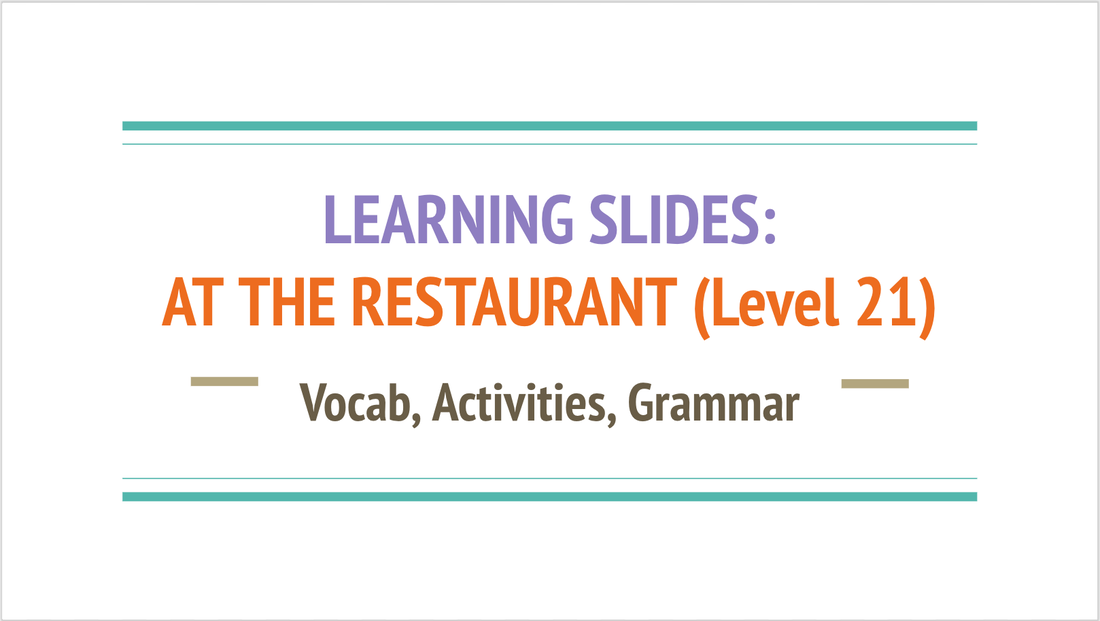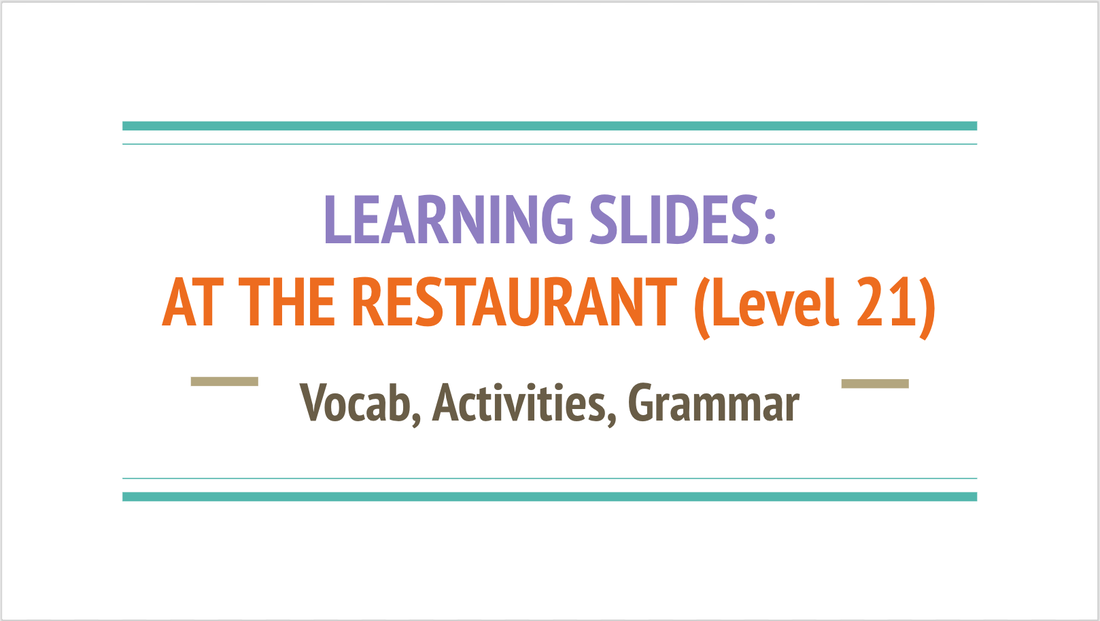Chapter 5: "Taste the Rainbow, Part 1"
HOW TO DESCRIBE FLAVOR
Preview
Lesson
Practice
Mastery
Preview
|
|
嫩 (nèn) [adj] tender
香 (xiāng) [adj] fragrant 油 (yóu) [n] oil; [adj] oily
清淡 (qīng dàn) [adj] light in flavor
新鲜 (xīn xiān) [adj] fresh
又...又 (yòu...yòu) both... and...
**Old Flavor Words**: 酸 (suān) [adj] sour 甜 (tián) [adj] sweet 咸 (xián) [adj] salty 辣 (là) [adj] spicy |
Lesson
Practice
TRAIN: write 3 sentences using the following grammar structure:
SPEAK: talk about which flavors you like, and which flavors you don't like. How do you prefer to eat your meals?
WRITE: write a review of a meal at a Chinese restaurant, focusing on its flavor.
- 又...又
SPEAK: talk about which flavors you like, and which flavors you don't like. How do you prefer to eat your meals?
WRITE: write a review of a meal at a Chinese restaurant, focusing on its flavor.
Mastery
DICTATION: write the Chinese characters, English definition, and pinyin (including tones):
GRAMMAR: complete the following exercises:
READING: read aloud the following sentences:
SPEAKING: perform the following conversation tasks:
- 嫩,香,油,清淡,新鲜,又...又...,酸*,甜*,咸*,辣*
- TARGET: no more than 1 mistake, including tones.
GRAMMAR: complete the following exercises:
- Translate: Their beef and broccoli is also quite good, both tender and fragrant.
- TARGET: no mistakes.
READING: read aloud the following sentences:
- 芥兰牛肉也挺好,又嫩又香。
- 行。服务员,菜要清淡一点儿,不要太油。
- 要是喜欢比较清淡的,就吃...
- 今天你们有什么新鲜的青菜吗?
- 我爱吃甜的;柯林爱吃辣的;雪梅爱吃咸的;张天明爱吃酸的。
- TARGET: no more than 1 mistake, including tones.
SPEAKING: perform the following conversation tasks:
- Talk about the flavors of different foods.
- TARGET: at least a 3 on ALL tasks.
Chapter 6: "Taste the Rainbow, Part 2"
HOW TO TALK ABOUT DIETARY PREFERENCES
Preview
Lesson
Practice
Mastery
Preview
多/少/别 + 放 (duō/shāo/bié...+ fàng) add more/add less/don’t add [ingredient]
**Old Ingredient Words**:
辣椒 (là jiāo) [n] chili pepper; hot pepper; chili
盐 (yán) [n] salt
糖 (táng) [n] sugar
醋 (cù) [n] vinegar
味精 (wèi jīng) [n] monosodium glutamate/MSG
肉 (ròu) [n] meat
素 (sù) [n] vegetables; vegetarian
Sentences:
- 多, 少, and 别 are here used like "adverbs" (as opposed to adjectives). They are placed before the verb to express the idea of doing something "more," "less," or "not at all."
- Use this structure for adding or subtracting flavoring:
- "sub + 多/少 + 放 + ingredient"
- If don't want to add that flavor at all, you can say "别 + 放 + noun" or "不 + 放 + noun"
- NOTE: ingredients are nouns, NOT adjectives/flavors (i.e. "add salt" = 放盐)
- 多+放+ingredient=add more [ingredient]
- 少+放+ingredient=add less [ingredient]
- 别+放+ingredient=don't add [ingredient]
- Examples:
- 1) 爸爸告诉妈妈做菜的时候少放盐, 多放点儿味精 = Dad told mom when making food to put less salt, put more MSG
- 2) 上中文课得多说中文,少说英文 = During class you should speak more Chinese, speak less English
- 3) 别放味精 = Don't put MSG
**Old Ingredient Words**:
辣椒 (là jiāo) [n] chili pepper; hot pepper; chili
- NOTE: 辣椒 = chili pepper (noun), 辣 = spicy (adj)
盐 (yán) [n] salt
- NOTE: 盐 = salt (noun), 咸 = salty (adj)
糖 (táng) [n] sugar
- NOTE: 糖 = sugar (noun), 甜 = sweet (adj)
醋 (cù) [n] vinegar
- NOTE: 醋 = vinegar (noun), 酸 = sour (adj)
味精 (wèi jīng) [n] monosodium glutamate/MSG
肉 (ròu) [n] meat
素 (sù) [n] vegetables; vegetarian
Sentences:
- 行。服务员,菜要清淡一点儿,别太咸,少放油,别放味精。
Lesson
Practice
TRAIN: write 3 sentences using the following grammar structure:
WRITE: you are a food guru. Write an article about things you should/should not eat in order to be healthy.
SKIT: in a group, write a dialogue between a waiter and customer at a restaurant. Memorize your skit and perform in front of the class!
- 多/少/别 + V
WRITE: you are a food guru. Write an article about things you should/should not eat in order to be healthy.
SKIT: in a group, write a dialogue between a waiter and customer at a restaurant. Memorize your skit and perform in front of the class!
- The customer has very specific dietary preferences.
- Waiter, make sure you get them right... oops!
Mastery
DICTATION: write the Chinese characters, English definition, and pinyin (including tones):
GRAMMAR: complete the following exercises:
READING: read aloud the following sentences:
SPEAKING: explain your dietary preferences and restrictions to a waiter [discuss all flavors we've learned so far]:
- 多/少/别 + 放,辣椒*,盐*,糖*,醋*,味精*,肉*,素*
- TARGET: no more than 1 mistake, including tones.
GRAMMAR: complete the following exercises:
- Rule: (in English) Explain how to tell the waiter to add more, add less, or not add different ingredients to your meal.
- Translate: Waitress, we'd like our food light [in flavor]. Please don't make it too salty. Not too much oil, no MSG.
- TARGET: no mistakes.
READING: read aloud the following sentences:
- 爸爸告诉妈妈做菜的时候少放盐, 多放点儿味精。
- 行。服务员,菜要清淡一点儿,别太咸,少放油,别放味精。
- TARGET: no more than 1 mistake, including tones.
SPEAKING: explain your dietary preferences and restrictions to a waiter [discuss all flavors we've learned so far]:
- Tell the waiter to add more of something.
- Tell the waiter to add less of something.
- Tell the waiter to not add any of something.
- TARGET: at least a 3 on ALL tasks.
Chapter 7: "Nectar of the Gods"
HOW TO DESCRIBE DIFFERENT CHINESE CUISINES
Preview
Lesson
Practice
Mastery
Preview
|
|
四大菜系 (sì dà càixì) [phrase] Four Great Cuisines of China
四川 (sì chuān) Sichuan [Chinese province] 广东 (guǎng dōng) Guangdong [Chinese province] 山东 (shān dōng) Shandong [Chinese province] 江苏 (jiāng sū) Jiangsu [Chinese province] 湖南 (hú nán) Hunan [Chinese province]
上海 (shàng hǎi) Shanghai [Chinese province] Sentences:
|
Lesson
Practice
SPEAK: talk about different regional Chinese cuisines. Which have you had? Which do you want to have? Why?
WRITE: translate the following sentences into Chinese:
WRITE: translate the following sentences into Chinese:
- The Four Great Cuisines of China are famous throughout China.
- Sichuan, Guangdong, Shandong, Jiangsu, and Hunan are provinces [省 (shěng)] of China.
- Shanghai food is really tasty.
Mastery
DICTATION: write the Chinese characters, English definition, and pinyin (including tones):
GRAMMAR: complete the following exercises:
READING: read aloud the following sentences:
SPEAKING: perform the following conversation tasks:
- 四大菜系,四川,广东,山东,江苏,湖南,上海
- TARGET: no more than 1 mistake, including tones.
GRAMMAR: complete the following exercises:
- Culture: Identify the Four Great Cuisines of China, and the provinces associated with those cuisines.
- TARGET: no mistakes.
READING: read aloud the following sentences:
- 我听我父母说中国各个地方的菜不一样,哪儿的菜最好吃?
- 我爱吃甜的,就喜欢上海菜;柯林爱吃辣的,就喜欢四川菜,湖南菜。
- TARGET: no more than 1 mistake, including tones.
SPEAKING: perform the following conversation tasks:
- Describe Chinese regional cuisines, including the Four Great Cuisines.
- TARGET: at least a 3 on ALL tasks.
Chapter 8: "Tournament of Champions"
HOW TO COMPARE THE FOUR GREAT CULINARY SCHOOLS OF CHINA
Preview
Lesson
Practice
Mastery
Preview
川菜 (chuān cài) Sichuan cuisine
粤菜 (yuè cài) Guangdong cuisine
鲁菜 (lǔ cài) Shandong cuisine
苏菜 (sū cài) Jiangsu cuisine
*淮扬菜* (huái yáng cài) Jiangsu cuisine [alternate name]
比方说 (bǐ fāng shuō) for example...
*比如* (bǐ rú) for example...
- 四川菜 or 川菜 = Sichuan cuisine. Very spicy from chili peppers and Sichuan peppercorn, which gives it a telltale fiery and tingling taste. Sichuan cuisine is also oily. Example dishes include 麻婆豆腐,宫保鸡丁,and 火锅.
粤菜 (yuè cài) Guangdong cuisine
- 广东菜 or 粤菜 = Guangdong cuisine/Cantonese cuisine. Takes advantage of the region's bountiful fresh seasonal produce and seafood. Flavors are fresh and fragrant, and typically light in flavor (not too spicy). Example dishes include 清蒸鱼,广东烤鸭,炒饭,和炒面.
鲁菜 (lǔ cài) Shandong cuisine
- 山东菜 or 鲁菜 = Shandong cuisine. With its coastline in the east and mountains in the west, Shandong gave rise to a varied cooking tradition emphasizing broths, seafood, and poultry. Shandong cuisine is typically salty—especially the soups—but not spicy. MSG is not commonly used. Example dishes include 糖醋鱼,新鲜白菜,and 凉拌黄瓜.
苏菜 (sū cài) Jiangsu cuisine
- 江苏菜 or 苏菜 = Jiangsu cuisine. Makes abundant use of the region's various types of tofu products and freshwater fish. Both 上海菜 and 杭州菜 are subcategories of 苏菜. Jiangsu cuisine has many sweet and sour flavors. Example foods include 家常豆腐,上海小笼包 (xiǎolóngbāo = Shanghai soup dumpling),and 红烧牛肉.
*淮扬菜* (huái yáng cài) Jiangsu cuisine [alternate name]
- 苏菜 is also commonly known as "淮扬菜" (named after specific cities in Jiangsu Province). 苏菜 and 淮扬菜 are basically the same thing, though 淮扬菜 is technically a branch of 苏菜.
比方说 (bǐ fāng shuō) for example...
- statement, + 比方说 + example
- Ex: 不同人喜欢吃不同的味道。比方说我爱吃甜的味道,但是我妈妈爱吃嫩的味道。= Different people like different flavors. For example I like sweet flavors, but my mom loves to eat tender flavors.
*比如* (bǐ rú) for example...
- also "比如说"
- used very similarly to 比方说, but a little bit more formal
- statement, + 比如(说) + example
- Ex: 这就要看你的口味了。比如我爱吃甜的,就喜欢上海菜;柯林爱吃辣的,就喜欢四川菜,湖南菜。
Lesson
Practice
RESEARCH: look at "Slideshow 1" about the Four Great Cuisines of China. Write out a paragraph summarizing the things you learned.
RESEARCH: look at "Slideshow 2" about the Four Great Cuisines of China. Write out a paragraph summarizing the things you learned.
SPEAK: talk about the Four Great Cuisines of China. What are the differences between them? Which ones have you tried? What did you think? Which ones did you like best (or think you would like best)?
WRITE: write a review of the Four Great Cuisines of China. Rank them in order of favorite to least favorite.
RESEARCH: look at "Slideshow 2" about the Four Great Cuisines of China. Write out a paragraph summarizing the things you learned.
SPEAK: talk about the Four Great Cuisines of China. What are the differences between them? Which ones have you tried? What did you think? Which ones did you like best (or think you would like best)?
WRITE: write a review of the Four Great Cuisines of China. Rank them in order of favorite to least favorite.
Mastery
DICTATION: write the Chinese characters, English definition, and pinyin (including tones):
GRAMMAR: complete the following exercises:
READING: read aloud the following sentences:
SPEAKING: perform the following conversation tasks:
- 川菜,粤菜,鲁菜,苏菜,*淮扬菜*,比方说,*比如*
- TARGET: no more than 1 mistake, including tones.
GRAMMAR: complete the following exercises:
- Culture: Identify the Four Great Cuisines of China using the abbreviated names.
- BONUS: Identify the Eight Great Cuisines of China.
- Culture: Identify at least two characteristics of each of the Four Great Cuisines.
- Translate: For example, I like it sweet, and so I like Shanghai cuisine.
- TARGET: no mistakes.
READING: read aloud the following sentences:
- 比方说我爱吃甜的,就喜欢上海菜;柯林爱吃辣的,就喜欢四川菜,湖南菜。
- 不同人喜欢吃不同的味道。比如我爱吃甜的味道,但是我妈妈爱吃嫩的味道。
- TARGET: no more than 1 mistake, including tones.
SPEAKING: perform the following conversation tasks:
- Describe Chinese regional cuisines, including the Four Great Cuisines.
- Compare and contrast the flavors and dishes of the Four Great Cuisines.
- Give examples to support your points.
- TARGET: at least a 3 on ALL tasks.
MINIBOSS #2: ACT 2 REVIEWMastery Challenge 1 (Vocabulary and Grammar):
Mastery Challenge 2 (Speaking):
BONUS CHALLENGES:
|
© 2019 Hugo Xiong. [email protected]








